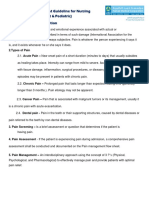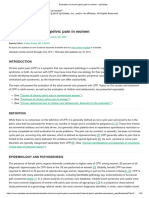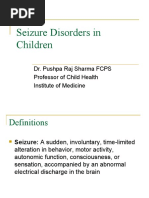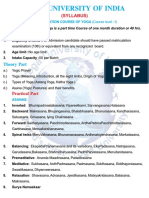0 ratings0% found this document useful (0 votes)
13 views10 Examination & Evaluation
10 Examination & Evaluation
Uploaded by
faariyaabdullah03The document discusses emergency procedures and primary care in physical therapy. It covers examining patients, investigating symptoms like location and history, and taking a patient health history including risk factors. Key areas discussed are evaluating if PT is appropriate, symptom investigation including location and behavior, and taking a thorough patient medical history.
Copyright:
© All Rights Reserved
Available Formats
Download as PPTX, PDF, TXT or read online from Scribd
10 Examination & Evaluation
10 Examination & Evaluation
Uploaded by
faariyaabdullah030 ratings0% found this document useful (0 votes)
13 views22 pagesThe document discusses emergency procedures and primary care in physical therapy. It covers examining patients, investigating symptoms like location and history, and taking a patient health history including risk factors. Key areas discussed are evaluating if PT is appropriate, symptom investigation including location and behavior, and taking a thorough patient medical history.
Copyright
© © All Rights Reserved
Available Formats
PPTX, PDF, TXT or read online from Scribd
Share this document
Did you find this document useful?
Is this content inappropriate?
The document discusses emergency procedures and primary care in physical therapy. It covers examining patients, investigating symptoms like location and history, and taking a patient health history including risk factors. Key areas discussed are evaluating if PT is appropriate, symptom investigation including location and behavior, and taking a thorough patient medical history.
Copyright:
© All Rights Reserved
Available Formats
Download as PPTX, PDF, TXT or read online from Scribd
Download as pptx, pdf, or txt
0 ratings0% found this document useful (0 votes)
13 views22 pages10 Examination & Evaluation
10 Examination & Evaluation
Uploaded by
faariyaabdullah03The document discusses emergency procedures and primary care in physical therapy. It covers examining patients, investigating symptoms like location and history, and taking a patient health history including risk factors. Key areas discussed are evaluating if PT is appropriate, symptom investigation including location and behavior, and taking a thorough patient medical history.
Copyright:
© All Rights Reserved
Available Formats
Download as PPTX, PDF, TXT or read online from Scribd
Download as pptx, pdf, or txt
You are on page 1of 22
EMERGENCY PROCEDURES
& PRIMARY CARE IN
PHYSICAL THERAPY
DR . BINISH ADEEL PT
BSPT,DPT, MSAPT
ASSISTANT PROFESSOR
EXAMINATION/EVALUATION
PROLOGUE
an event or act that leads to another.
A primary objective of the examination process is deciding whether :
•PT intervention is appropriate
•Consultation with another health care provider is required along with PT intervention
•PT intervention is not indicated and the patient needs to be managed by another health care
provider
SYMPTOMS INVESTIGATION
•The symptom investigation includes subcategories of symptom location, onset (history) of
symptoms and behavior of symptoms
LOCATION OF SYMPTOMS
Use of a body chart helps to locate symptoms location, including pain, paresthesia , numbness
and weakness.
LOCATION OF SYMPTOMS
•Ithe figure it shows that the patient has low lumbar and right buttock pain (dull ache)
•The next question could be any pain, pins, needles, weakness and /or numbness at the back ,
down the leg or different areas/ parts of the body.
•The patients might not tell that they belly pain or facial pain because they have a rationale why
does my PT need to know if my stomach hurts?
•In addition patient may miss an area of less intensity.
•Asymptomatic area should be marked check on body chart. Why ?
•Patients description of symptoms
•For eg: patient tells she has pain, stiffness , aching, and sharp soreness over a body area.
•PT must assess each pain descriptor independently.
•Similar pattern (aggravating or relieving factors) would lead to know that three symptoms are
related to the same lesion.
•Pain from visceral region structures typically would be thought to be located in the anterior
chest wall or abdominal regions, but a number of viscera are located in the retroperitoneal
regions.
•Knowledge of potential pain patterns associated with viscera can guide the PT in selecting the
organ systems to screen with review of systems questioning.
•Finally, knowing the pain patterns associated with various diseases will help PTs know which
disorders should be suspected.
SYMPTOM HISTORY
•For many patients , the current episode of symptoms is not the first episode, if after 5 minute
conversation of incident of 20 years ago pain, PT might conclude that he has learned nothing
that influences todays cdm.
•To promote practice efficiency , start with the current or most recent episode , and then work
backward chronologically to the initial event..
•Impairments – related symptoms typically are associated with a traumatic incident , an accident
, repetitive overuse, or sustained postural strains. Many patients cannot relate the onset of their
symptoms to any particular incident or accident.
BEHAVIOUR OF SYMPTOMS
THE PT should ask questions about :
•The relationship symptoms have to rest, activities , time of day ( morning, midday, evening or
night ) and positions /postures.
•The consistancy, frequency and durations of symptoms , including fluctuations in intensity
•For neuro-musculoskeletal disorders a 24 hours period is adequate.
•Symptoms associated with movement disorders typically changes as the mechanical loads on
the body increase or decrease with time of day, onset or cessation of specific activities and
postures.
•Symptoms associated with visceral disease will vary in their behavior depending on the severity
of the disorder and the function of the structure.
•For eg: patients thoracic-spine pain is the result of the duodenal ulcer GI system activity may
later the symptoms. Pain due to ulcer will be reduced shortly after the patient eats , because
food acts as a buffer and a few hours after eating the pain will return or intensify.
•An inconsistent pattern of change in symptom intensity is not the only warning sign that may be
discovered during behavior of symptom questioning.
•Eg: patients notes right shoulder and wrist pain during the initial visit and at the second visit
reports right and left shoulder and left elbow and wrist pain. the patient cannot describe any
reason why the apparently new pains have started.
•Primary neurological, endocrine, or rheumatic disorders or adverse drug reactions may account
for a symptom pattern like this.
•Night pain
•Associated with serious pathology like cancer and infection.
•check .for red flags
•Many studies shows is associated with DJD
PATIENT HEALTH HISTORY INCLUDING
IDENTIFICATION OF HEALTH RISK FACTORS
•Patients demographics
•Patient’s social history
•Patients medical history
•Social habits
•Family history
‘THANKYO
U!
You might also like
- Case Study - HY DairiesDocument4 pagesCase Study - HY DairiesAishah At-Thahirah100% (7)
- Approach To Differential Diagnosis PDFDocument62 pagesApproach To Differential Diagnosis PDFanasNo ratings yet
- Schedule of Benefits - Basic (Abu Dhabi) PlanDocument1 pageSchedule of Benefits - Basic (Abu Dhabi) PlanSenathipathi KalimuthuNo ratings yet
- lec 6Document27 pageslec 6Hira NawazNo ratings yet
- AssessmentDocument24 pagesAssessmentNikhil TiwariNo ratings yet
- Capsulitis AdhesivaDocument5 pagesCapsulitis AdhesivaCesar GuevaraNo ratings yet
- Quick Guide For Physiotherapists Low Back Pain Clinical Care StandardDocument11 pagesQuick Guide For Physiotherapists Low Back Pain Clinical Care StandardcontactoviphyaNo ratings yet
- Educational Topic 39: Chronic Pelvic Pain: U 3: G S A: G GDocument3 pagesEducational Topic 39: Chronic Pelvic Pain: U 3: G S A: G GStetho LoveNo ratings yet
- 5 02 Acute Abdominal PainDocument17 pages5 02 Acute Abdominal PainNereida LechugaNo ratings yet
- Evaluation of The Adult With Abdominal Pain UpToDateDocument21 pagesEvaluation of The Adult With Abdominal Pain UpToDateRQW PhươngNo ratings yet
- HISTORYDocument28 pagesHISTORYrxmskdkd33No ratings yet
- Chronic Pain - HO Lecture ShortDocument28 pagesChronic Pain - HO Lecture Shortrajvikram87No ratings yet
- NCP Nursing Diagnosis: Acute PainDocument4 pagesNCP Nursing Diagnosis: Acute Painphvega06No ratings yet
- Clasificación Dolor OrofacialDocument8 pagesClasificación Dolor OrofacialCindy Bernal MNo ratings yet
- Acute and Chronic Low Low Back PainDocument13 pagesAcute and Chronic Low Low Back PainMilner GranadosNo ratings yet
- Guidelines For DoctorsDocument18 pagesGuidelines For Doctorsmh125fizanNo ratings yet
- The Fifth Vital SignDocument7 pagesThe Fifth Vital SignMaribee Tagayun Espiritu100% (1)
- Physiotherapy Treatment On Chronic Non Specific Low Back PainDocument31 pagesPhysiotherapy Treatment On Chronic Non Specific Low Back PainAnonymous mWAaDZmlJwNo ratings yet
- Evaluation of The Adult With Abdominal Pain - UpToDateDocument13 pagesEvaluation of The Adult With Abdominal Pain - UpToDateAudricNo ratings yet
- TonsillectomyDocument50 pagesTonsillectomyChikinPhukkoNo ratings yet
- Acute Pain Nursing DiagnosisDocument5 pagesAcute Pain Nursing DiagnosisAngelo Cuaresma0% (1)
- 9.pain ManagementDocument24 pages9.pain ManagementhebaNo ratings yet
- ABDOMEN Agudo EnfrentamientoDocument22 pagesABDOMEN Agudo Enfrentamientonicositja_vangoh91No ratings yet
- Gullian Barre SyndromeDocument26 pagesGullian Barre SyndromeArslan AslamNo ratings yet
- Acute AbdomenDocument51 pagesAcute AbdomenOthieno IvanNo ratings yet
- Evaluation of The Adult With Abdominal PainDocument11 pagesEvaluation of The Adult With Abdominal PaintsunderehimesamaNo ratings yet
- LBP-case Report PresentDocument36 pagesLBP-case Report Present林松No ratings yet
- Introduction To Screening & Differntial DiagnosisDocument42 pagesIntroduction To Screening & Differntial DiagnosisHUSNAIN TECH AND FUNNo ratings yet
- PNS Pain Management Guideline For Nursing CompetencyDocument10 pagesPNS Pain Management Guideline For Nursing Competencyvhon100% (1)
- Acute Abdominal PainDocument17 pagesAcute Abdominal PainmarselNo ratings yet
- Pec WebDocument4 pagesPec Webapi-233655790No ratings yet
- Nurs 65 Medical Surgical Nursing: Cavite State UniversityDocument14 pagesNurs 65 Medical Surgical Nursing: Cavite State UniversityDennis Nyambane MomanyiNo ratings yet
- Somatoform DisordersDocument21 pagesSomatoform DisordersVinitaNo ratings yet
- Grieve and LossDocument6 pagesGrieve and LossRuffy AbdulazisNo ratings yet
- Acute Pain Nursing Diagnosis & Care Plans - NurseTogetherDocument22 pagesAcute Pain Nursing Diagnosis & Care Plans - NurseTogetherrachealakusukNo ratings yet
- англDocument4 pagesанглЛюбов ВітькоNo ratings yet
- 3rd Year Introduction NOTESDocument21 pages3rd Year Introduction NOTESalexandermason2003No ratings yet
- Stan Checketts Comprehensive AssessmentDocument13 pagesStan Checketts Comprehensive AssessmenttmallonNo ratings yet
- 43-44 - Muscuskeletal DisordersDocument39 pages43-44 - Muscuskeletal DisordersTaif SalimNo ratings yet
- Apendicitis Acute UnpadDocument28 pagesApendicitis Acute UnpadKharisma AstiNo ratings yet
- Management of Pain: Mohamed Khashaba, MD Professor of Pediatrics/Neonatology Head NICUDocument79 pagesManagement of Pain: Mohamed Khashaba, MD Professor of Pediatrics/Neonatology Head NICUlordoftheweb100% (1)
- Assessing Pain: The Fifth Vital SignDocument58 pagesAssessing Pain: The Fifth Vital SignErica GyeolsilNo ratings yet
- Evaluation of Chronic Pelvic Pain in Women - UpToDateDocument32 pagesEvaluation of Chronic Pelvic Pain in Women - UpToDatemedicinapapNo ratings yet
- DD Intro For MsDocument54 pagesDD Intro For MsZuhaib AhmedNo ratings yet
- EAU Guidelines On Chronic Pelvic Pain 2023 31Document1 pageEAU Guidelines On Chronic Pelvic Pain 2023 31falcontower1No ratings yet
- Shamal MSDocument16 pagesShamal MSSyeda MunazzaNo ratings yet
- Tally and O'Connor's Clinical Examination (8 Edition, Volume 1) Notes & Summaries by Yasin KadriDocument9 pagesTally and O'Connor's Clinical Examination (8 Edition, Volume 1) Notes & Summaries by Yasin KadriYasin KadriNo ratings yet
- Clinical Case 38-Chronic Pelvic PainDocument2 pagesClinical Case 38-Chronic Pelvic Painselina kalenderNo ratings yet
- NCP Nursing DiagnosisDocument24 pagesNCP Nursing Diagnosisphvega06No ratings yet
- Pain in Chest and Left ArmDocument14 pagesPain in Chest and Left ArmCarlos GuiterizNo ratings yet
- Perioperative NursingDocument8 pagesPerioperative NursinglovethestarNo ratings yet
- CLASSIFICATION - OF - Low Back PainDocument28 pagesCLASSIFICATION - OF - Low Back PainJasmine ShahNo ratings yet
- Acute Pain AGEDocument2 pagesAcute Pain AGEHarris AustriaNo ratings yet
- Fast Facts: Perioperative Pain: Effective Management Has Numerous BenefitsFrom EverandFast Facts: Perioperative Pain: Effective Management Has Numerous BenefitsNo ratings yet
- Holistic Pain Relief: How to ease muscles, joints and other painful conditionsFrom EverandHolistic Pain Relief: How to ease muscles, joints and other painful conditionsNo ratings yet
- Postherpetic Neuralgia: A Beginner's Quick Start Guide to Managing Shingles Through Diet, With Sample Curated RecipesFrom EverandPostherpetic Neuralgia: A Beginner's Quick Start Guide to Managing Shingles Through Diet, With Sample Curated RecipesNo ratings yet
- The Breakthrough Back Pain Healing and Relief Plan: The book that unlocked the secrets of back pain care, sciatica pain relief naturally via diet, exercises & understanding the mind-body connectionFrom EverandThe Breakthrough Back Pain Healing and Relief Plan: The book that unlocked the secrets of back pain care, sciatica pain relief naturally via diet, exercises & understanding the mind-body connectionNo ratings yet
- Irritable Bowel Syndrome: Heal Your Gut Naturally in 90 Days!From EverandIrritable Bowel Syndrome: Heal Your Gut Naturally in 90 Days!No ratings yet
- NURSING CARE PLAN Problem: Body Malaise Nursing Diagnosis: Activity IntoleranceDocument2 pagesNURSING CARE PLAN Problem: Body Malaise Nursing Diagnosis: Activity IntoleranceLaGlaGan Group60% (5)
- SDM - Workshop Book ws1Document28 pagesSDM - Workshop Book ws1容一维0% (1)
- A Study To Assess The Knowledge Regarding Newborn Danger Signs Among Staff Nurses in Selected Hospital in Kanpur, Uttar Pradesh With A View To Develop An Information BookletDocument7 pagesA Study To Assess The Knowledge Regarding Newborn Danger Signs Among Staff Nurses in Selected Hospital in Kanpur, Uttar Pradesh With A View To Develop An Information BookletEditor IJTSRDNo ratings yet
- Resolution No. 111, Series of 2020Document3 pagesResolution No. 111, Series of 2020MaiAsisNo ratings yet
- Esfj Strengths and WeaknessesDocument15 pagesEsfj Strengths and WeaknessesAmelindaNo ratings yet
- Watts Q1M1W1Document2 pagesWatts Q1M1W1Sekora LeeNo ratings yet
- Segmentation:: DemographyDocument4 pagesSegmentation:: DemographyIshtiaq ShushaanNo ratings yet
- Diagnosis and Treatment of IBSDocument13 pagesDiagnosis and Treatment of IBSacvarelaNo ratings yet
- Water Can Kill - pg.1-3Document3 pagesWater Can Kill - pg.1-3Shinichi TakebeNo ratings yet
- Types of EpilepsyDocument2 pagesTypes of EpilepsyAkshayaaNo ratings yet
- Abdominal Distension: Supervised BY: Done BYDocument4 pagesAbdominal Distension: Supervised BY: Done BYŽäíñäb ÄljaÑabìNo ratings yet
- Disaster Risk Reduction and Management Some Basic ConceptsDocument2 pagesDisaster Risk Reduction and Management Some Basic ConceptsLG BaganiNo ratings yet
- Hospital Construction Project: By: Amrah Arif Hamza Naeem Saleha Sugrio Zaid Baig Laiba KhanDocument45 pagesHospital Construction Project: By: Amrah Arif Hamza Naeem Saleha Sugrio Zaid Baig Laiba KhanamrahNo ratings yet
- Hiv Aids Work PolicyDocument22 pagesHiv Aids Work PolicyquarozNo ratings yet
- Egerton Human Resource Policy NewDocument38 pagesEgerton Human Resource Policy NewOloo Yussuf Ochieng'No ratings yet
- 8A Year 8 ScienceDocument7 pages8A Year 8 SciencemkaoukNo ratings yet
- Traumatic Brain InjuryDocument19 pagesTraumatic Brain InjurySatwik MacharlaNo ratings yet
- Cgpa CalculatorDocument1 pageCgpa CalculatorIlyas KhanNo ratings yet
- ADC Professional Competencies Accessible DentistsDocument7 pagesADC Professional Competencies Accessible DentistsNguyen NganNo ratings yet
- Classification of MelanomaDocument93 pagesClassification of MelanomaTrang Huyền VũNo ratings yet
- How To Take Movicol: Contact DetailsDocument2 pagesHow To Take Movicol: Contact DetailsreaderNo ratings yet
- Nail CareDocument4 pagesNail CareEliakim SuminlaoNo ratings yet
- Seizure Disorders in ChildrenDocument18 pagesSeizure Disorders in ChildrenWan AklimaNo ratings yet
- FullDocument55 pagesFullsirineech9No ratings yet
- 6 Laboratory SafetyDocument17 pages6 Laboratory SafetyNipun ShamikaNo ratings yet
- Jurnal SR 3Document12 pagesJurnal SR 3Zaina Khairunisa AsyaNo ratings yet
- 1 - Syllebus of Yoga CoursesDocument11 pages1 - Syllebus of Yoga CoursesJilla VishwasNo ratings yet
- Managment Occupation Health and Safety 5th Edition Kevin Test BankDocument10 pagesManagment Occupation Health and Safety 5th Edition Kevin Test Bankodileguinevereqgpc5d100% (41)

























































































